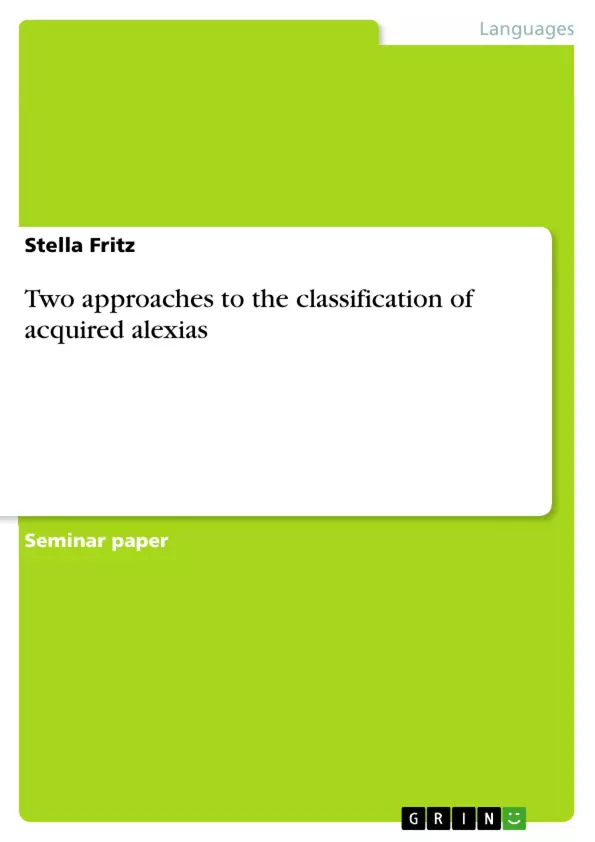There is a wide range of reading disabilities that has aroused the interest of scientists and neurologists, who have been trying to analyse and classify them. The focus of this term paper is on the varieties of acquired reading disorders. It is intended to provide a broad and understandable overview of the different forms of alexia with their underlying defects. They will be presented with respect to two main approaches, namely the traditional approach from a neurological point of view and the psycholinguistic approach from a neurolinguistic point of view.
The traditional approach divides alexias into major clinical syndromes with regard to the reading deficit. There is a wide range of terms for this syndrome, referring either to accompanying deficits like apraxia, agraphia or acalculia or to the anatomical locus of the lesion.
With the advent of cognitive neuropsychology in recent years, theorists have developed a new classification system for reading disturbances that follow brain damages. They were interested in developing a model of how the psycholinguistic process of reading operates based on the sorts of reading patterns they see in alexic patients. Therefore, their psycholinguistic approach divides alexias with respect to the reading mechanisms of brain-damaged people.
Table of Contents
- INTRODUCTION
- CLASSIFICATION OF ACQUIRED ALEXIAS
- Traditional Approach
- Posterior Alexia
- Central Alexia
- Anterior Alexia
- A Psycholinguistic Approach
- Surface Alexia
- Phonological Alexia
- Deep Alexia
- CONCLUSION
Objectives and Key Themes
This term paper aims to provide a comprehensive overview of different forms of acquired reading disorders, known as alexias. The focus is on presenting the varieties of alexia within two main approaches: the traditional approach from a neurological perspective and the psycholinguistic approach from a neurolinguistic perspective.
- Classification of acquired alexias based on traditional neurological syndromes
- A psycholinguistic approach to classifying alexias based on reading mechanisms
- The distinction between acquired and developmental reading disabilities
- The underlying neurological and cognitive deficits associated with different types of alexia
- The relationship between reading, writing, and language processing in alexia
Chapter Summaries
The paper begins by introducing the concept of alexia, distinguishing it from developmental reading disabilities like dyslexia. It emphasizes the importance of understanding the different types of alexias and their underlying neurological and cognitive deficits.
The paper then delves into the traditional approach to classifying alexias, highlighting the major clinical syndromes identified by neurologists. This section discusses the distinction between literal alexia, verbal alexia, and global alexia, emphasizing the importance of understanding the reading deficit and accompanying neurological symptoms.
The paper further explores the concept of posterior alexia, also known as pure alexia or alexia without agraphia. It examines the specific symptoms of posterior alexia, including the inability to read but preservation of writing ability, the presence of right homonymous hemianopsia, and the absence of other language deficits.
Keywords
This paper focuses on acquired alexias, exploring the various types of reading disorders caused by brain damage. Key terms include: alexia, acquired reading disorders, traditional approach, neurological syndromes, psycholinguistic approach, reading mechanisms, surface alexia, phonological alexia, deep alexia, posterior alexia, central alexia, anterior alexia, literal alexia, verbal alexia, global alexia, agraphia, right homonymous hemianopsia.
- Quote paper
- Stella Fritz (Author), 2018, Two approaches to the classification of acquired alexias, Munich, GRIN Verlag, https://www.grin.com/document/465276



